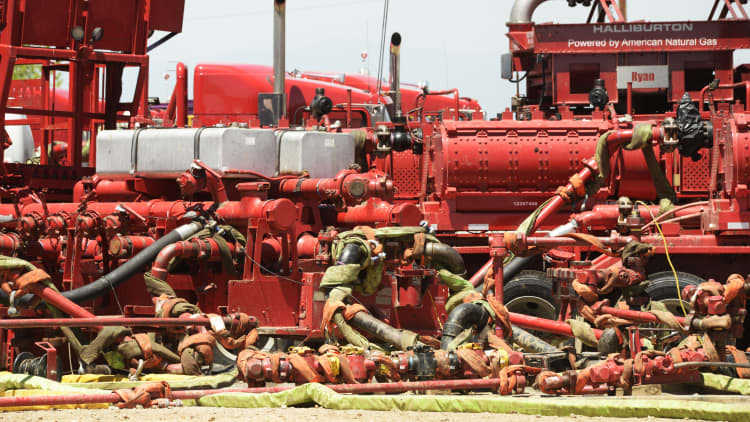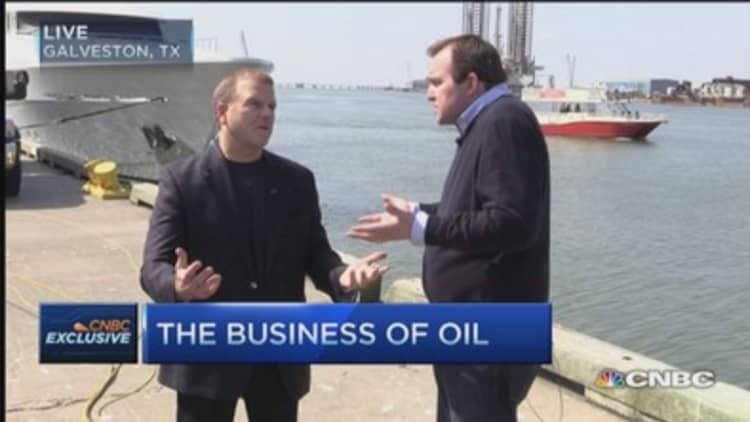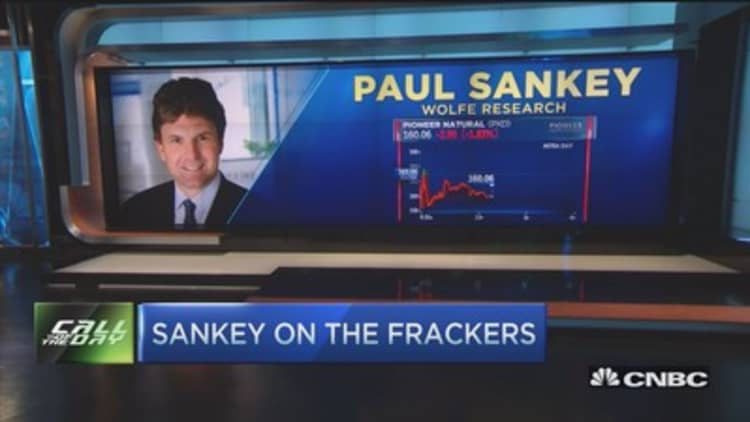In good times, Big Roy Trucking runs 17 trucks to haul water to and from the Bakken oilfields. In the first quarter of this year, the family owned business scaled back to just the 11 trucks it owns.
But recently, Big Roy has been able take two of its subcontractors back on, and Trista Rust, whose husband and father-in-law run the business, is optimistic drilling will pick up again.
"People are getting more relaxed as oil stabilizes and even rebounds," she said. "The trend seems to be that things are picking up."
Read MoreOil at $60—get ready for 'frack counterattack'
The Rusts' experience reflects the belief among many that the worst of the job cutbacks in the U.S. oil patch may be over—for now, at least. (Tweet This)
On Thursday, data from Challenger, Gray & Christmas showed energy sector cuts spiked to 19,745 in April after falling by 92 percent month over month to 1,279 layoffs in March.
The energy sector has led the nation in layoff announcements every month but one this year, as falling crude prices have translated into an uptick in pink slips. Since January, employers have announced about 57,556 layoffs, compared with about 2,400 in the same period last year.
To be sure, not all of those cuts will hit American workers. Oilfield services firm Schlumberger, which employs staff globally, accounted for more than half of the April layoffs. It said it would cut an additional 11,000 workers on top of a previously announced 9,000 layoffs.
Read MoreOil top may be in, and it could get ugly: Analyst
Energy companies are assessing whether they've pared back enough—or cut too deeply, said Gladney Darroh, managing partner at energy recruiting firm Piper-Morgan. While a nearly 40 percent rally in crude prices since January has brightened the energy outlook, drillers are not yet convinced the run-up will continue, and the wait-and-see period could last another three to five months, he added.
"I think we'll continue to bump along the bottom for a while, but I think the more significant layoffs are behind us, at least for the next quarter or two," Darroh told CNBC.
When—and why—things could get tight again
The other shoe may yet drop in September, however, when banks revisit the value of drillers' reserves, particularly those of midsize and independent oil and gas companies, Darroh said. At that point, banks will determine whether assets on companies' books provide adequate collateral against their lines of credit. They'll do so the same way they always do—by looking at the average oil price, year over year, for the prior four quarters. In September, they'll be factoring in a full year of lower prices.
"The numbers are not going to look good, and the banks are going to force some of these companies to sell properties," Darroh said. "It's going to be very, very tough. That's when you may see more M&D activity."
Further job reductions or Chapter 11 bankruptcy filings may well pick up, as well, he said.
The states that are hurt worst



Job cuts have thus far been concentrated in Texas, where the energy industry employs about 370,000 workers, but the economy there is far less dependent on crude than it was during the 1980s oil glut and more diversified than other major energy-producing states. The drop in oil prices most affects employment in Wyoming, Oklahoma and North Dakota, according to a report by the Dallas Federal Reserve.
The pink slips have stopped rolling in for now, but paychecks and benefits remain under pressure. Employers are limiting or eliminating bonuses and stock awards. They're also setting lower expectations for base pay increases, and sometimes freezing salaries, Darroh said.
"Firms have sharply cut capital expenditures, and many are also reducing employment and hours," said Chad Wilkerson, an economist and Oklahoma City branch executive at the Kansas City Federal Reserve Bank, which covers Wyoming and Oklahoma.
Read MoreHere's how the private equity industry views oil
In an April 10 Kansas City Fed survey of 32 energy firms in Western states, one-third of respondents said they expect wages and benefits to be lower within six months, and just 9 percent expected them to rise during the same period.
So far, producers have not pulled workers out of No. 2 oil-producing state North Dakota, but hiring has ground to a halt, recruiters say.
Melissa McElfish, president of Energy Recruiting Services, said she's seen the biggest impact in the state's prolific Bakken oilfields. She said she suspects the industry is trying to rein in labor costs, which have spiked in recent years.
Average weekly earnings for oilfield workers in the Bakken soared 53 percent in five years leading up to the third quarter of 2014, to about $1,350. The national average is only $979.
The good news is that we are seeing something on the order of 75 percent of the people that get laid off are able to secure a position in those first 30 to 60 days. The industry is absorbing the talent that's hitting the street, by and large.Jeff Bushpresident, CSI Recruiting
At McElfish's Coeur d'Alene, Idaho, office, resumes are stacking up for junior line bosses and field managers, suggesting that exploration and production firms are asking higher-ups to take greater responsibility for running well sites, she said. Coiled tubing companies that provide equipment for hydraulic fracturing have also been sidelined as drillers frack fewer new wells and focus on their most productive assets.
Energy Recruiting Services, founded four years ago, has been able to weather the downturn in part because it focuses primarily on providing drivers. McElfish said she has seen little change in the number of entrepreneurs forming owner-operator businesses, which exploration and production firms hire to haul water, oil and gas, and equipment rather than investing in their own fleets.
Read More Rolls-Royce—yes, Rolls-Royce—to make fracking equipment
The U.S. Energy Information Administration expects the nation's production to begin falling this month, but new supply has held steady above 9 million barrels per day.
"The oil is still there. They might not be drilling more wells, but the oil is still coming out, and that means work," McElfish said.
The same holds true for petroleum engineers, said Jeff Bush, president of Dallas-based CSI Recruiting. While exploration and production engineers have been hit as new drilling drops off, reservoir engineers have been relatively insulated because they specialize in optimizing wells, a skill in high demand as energy firms seek to wring every last drop of productivity from their assets.
The initial bloodletting has subsided, and laid-off workers are not staying on the sidelines for long, Bush said.
"The good news is that we are seeing something on the order of 75 percent of the people that get laid off are able to secure a position in those first 30 to 60 days," Bush said. "The industry is absorbing the talent that's hitting the street, by and large."


